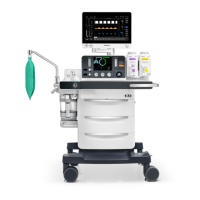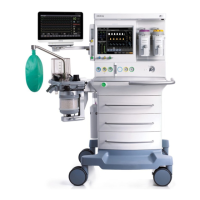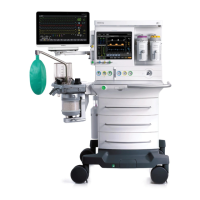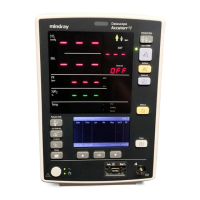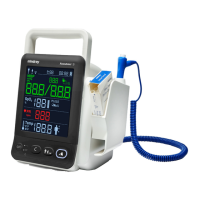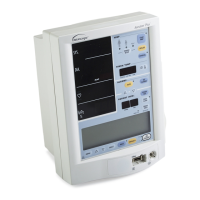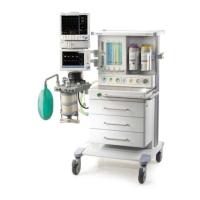A5/A3™ Operating Instructions 046-003777-00 4 - 5
Preoperative Tests Pre-Operative Checkout List
4. Check that the vaporizers are properly installed and sufficiently filled and that filler ports are
tightly closed. Verify that only one vaporizer turns ON at a time (see ‘‘Install the Vaporizer’’
on page 2-5).
5. Perform a 40 cmH
2
O manual leak test. If present, set the left vaporizer to ON and perform a
40 cmH
2
O manual leak test. Set the vaporizer to OFF. Repeat for the right vaporizer if
installed (see
“Manual Leak Test” on page4-22).
6. Perform a vaporizer leak test for each vaporizer installed on the A5/A3 system (see
“Vaporizer Leak Test” on page4-22).
7. Check that the function of Anesthetic Gas Scavenging System is normal (see “Inspect the
Active/Passive Anesthetic Gas Scavenging System” on page4-29).
8. Drain any moisture from the breathing system water trap and the condensation drain valve
at the bottom of the absorber canister assembly.
Prior to each patient, before administering anesthesia, the following should be done:
1. Inspect the A5/A3 for damage or hazardous conditions; ensure all necessary equipment and
supplies are present, e.g., drugs, CO
2
absorbent (not exhausted), breathing circuits and tank
wrench.
2. Check that central supply O
2
, N
2
O and Air pressures are each within the pipeline input range
specifications (i.e., 40 to 87 psi).
3. Check that O
2
, N
2
O and Air flowmeters operate properly: Check that all flow levels on the
monitor screen are at zero flow with flow-control valves closed. Adjust flow of all gases
through their full ranges and check for erratic movements of the gas levels.
4. Check that a hypoxic mixture of less than 21% O
2
may not be administered: Attempt to
create an hypoxic O
2
/ N
2
O mixture by slowly opening the N
2
O flow control valve fully with
the O
2
flow valve fully closed (no N
2
O gas should be flowing). Then, slowly open the O
2
flow
valve and observe O
2
and N
2
O rise in proportion to maintain a minimum concentration of
21% O
2
in fresh gas.
5. Perform a vaporizer leak test for each vaporizer installed on the A5/A3 system (see
“Vaporizer Leak Test” on page4-22).
6. Verify that Auxiliary O
2
and Air are available and functioning.
7. Verify that a Self-inflating Manual Ventilation device is available and functioning.
8. Check that the O
2
, N
2
O, and Air cylinders (if present) are mounted on the A5/A3, have
adequate pressure, and no high pressure leaks are present (see “Cylinder Tests” on page4-
20).
9. Check that valves on the O
2
, N
2
O, and Air cylinders (if present) are closed until needed to
prevent unintentional use of gas.
10. With a breathing circuit and reservoir bag attached, check that the unidirectional valves
operate by visual inspection.
11. Check ventilation capability in Standby, Manual, VCV and PCV ventilator modes.
12. Check that patient suction is adequate to clear the airway.
13. Verify ability of required monitors and check alarms.
The following step is recommended to be performed when prompted by the machine:
• Complete the 21% O
2
Calibration (see “O
2
Sensor Calibration” on page7-6).
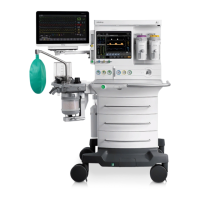
